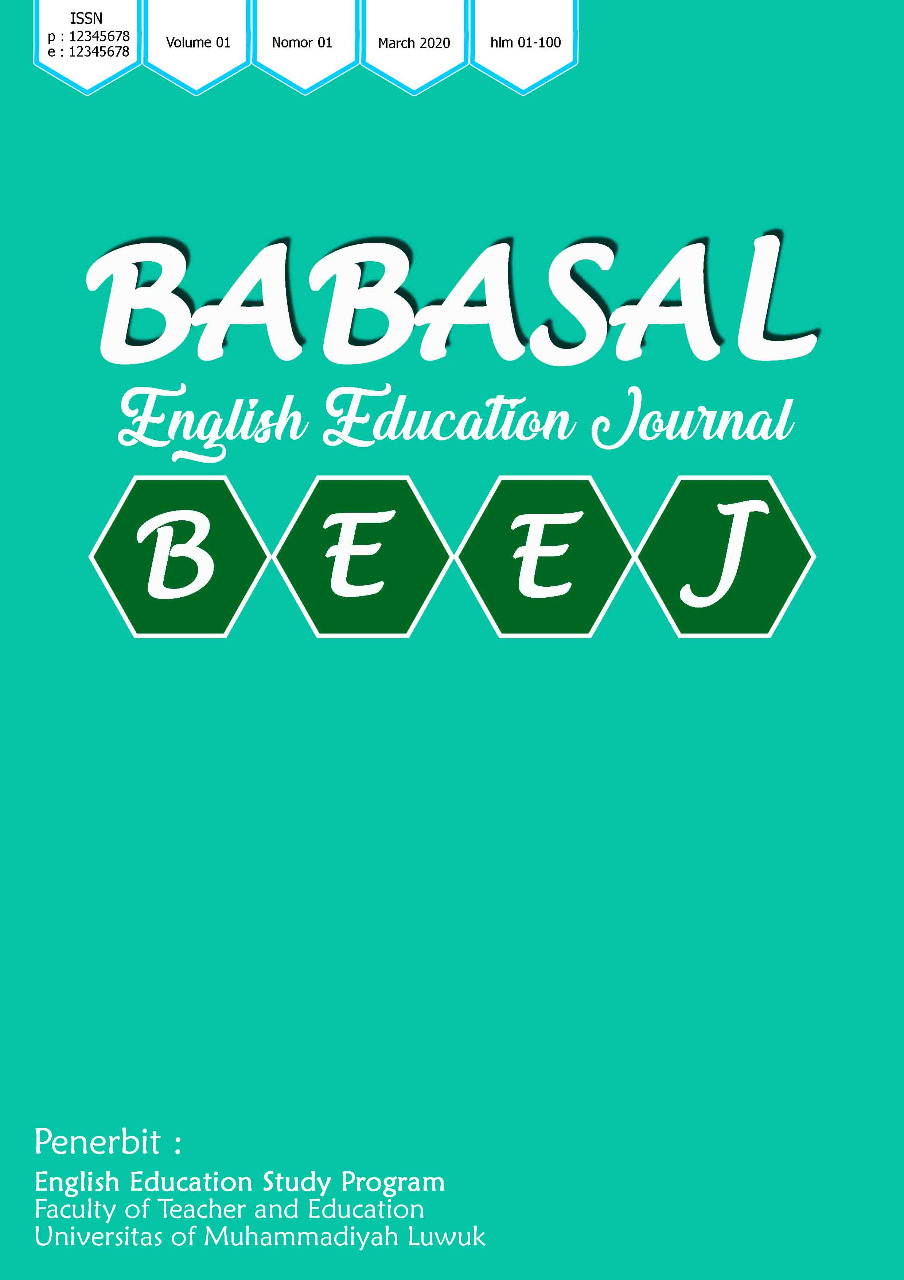The Practice of Interactive Multimedia to Improve Students Procedure Text Learning
DOI:
https://doi.org/10.32529/beej.v5i2.3456Keywords:
Interactive Multimedia,, Writing, Procedure Texts, , Learning Outcomes, , PaddletAbstract
In the era of technology-based education, it is crucial to understand the effectiveness of interactive media in enhancing students' comprehension of specific text types. This study aims to examine the practice of interactive media to student learning outcomes at SMP IT Wahdah Islamiyah Makassar regarding Procedure texts. The subjects in this study are 20 students of IX B1 Class. This study used pre-experimental/one-shot case study research to compare learning outcomes. The data collection method is the academic performance outcomes of the students and field notes analyzed quantitatively. The findings showed significant differences in student understanding when receiving instruction with interactive multimedia then before. Students after taught using interactive multimedia show a higher level of understanding of the Procedural Text. Therefore, the use of interactive multimedia in the teaching of Procedure Texts is highly recommended as it significantly improves students' understanding and is well received by students. Although the integration of interactive multimedia in the classroom is increasing, there is still a gap in understanding its specific impact on student learning outcomes for Procedural Texts.
References
Abdulrahaman, M. D., Faruk, N.(2020), Oloyede, A. A., Surajudeen-Bakinde, N. T., Olawoyin, L. A., Mejabi, O. V., ... & Azeez, A. L. (2020). Multimedia tools in the teaching and learning processes: A systematic review. Heliyon, 6(11).
Asad, M. M., Naz, A., Churi, P., & Tahanzadeh, M. M. (2021). Virtual reality as pedagogical tool to enhance experiential learning: a systematic literature review. Education Research International, 2021(1), 7061623.
Bean, J. C., & Melzer, D. (2021). Engaging ideas: The professor's guide to integrating writing, critical thinking, and active learning in the classroom. John Wiley & Sons.
Brookfield, S. D. (2015). The skillful teacher: On technique, trust, and responsiveness in the classroom. John Wiley & Sons.
Brown, A. L. (1992). Design experiments: Theoretical and methodological challenges in creating complex interventions in classroom settings. The journal of the learning sciences, 2(2), 141-178.
Dissertations, M., & Scruggs, B. B. (2009). Learning Outcomes in Two Divergent Middle School String Orchestra Classroom Environments: A Comparison of a LearnerCentered and a TeacherCentered Approach. https://doi.org/10.57709/1062205
Hoidn, S., & Reusser, K. (2020). Foundations of student-centered learning and teaching. In The Routledge international handbook of student-centered learning and teaching in higher education (pp. 17-46). Routledge.
Lee, S. M. (2022). A systematic review of context-aware technology use in foreign language learning. Computer assisted language learning, 35(3), 294-318.
Liew, T. W., Mat Zin, N. A., & Sahari, N. (2017). Exploring the affective, motivational and cognitive effects of pedagogical agent enthusiasm in a multimedia learning environment. Human-centric Computing and Information Sciences, 7, 1-21.
Made Rajendra, I., & Made Sudana, I. (2018). The Influence of Interactive Multimedia Technology to Enhance Achievement Students on Practice Skills in Mechanical Technology. Journal of Physics: Conference Series, 953(1). https://doi.org/10.1088/17426596/953/1/012104
Nisa, S. U. (2024). USE OF MULTIMEDIA TOOLS AND APPLICATIONS TO IMPROVE ENGLISH LANGUAGE LEARNING AND TEACHING. Journal of Southwest Jiaotong University, 59(3).
Reed, S. K. (2006). Cognitive architectures for multimedia learning. In Educational Psychologist (Vol. 41, Issue 2, pp. 87–98). https://doi.org/10.1207/s15326985ep4102_2
Rockwell, M. G., & Mactavish, A. (n.d.). What is Multimedia? http://search.eb.com/bol/topic?eu=1461&sctn=1
Salom, S. N. (2023). An investigation on the efficacy of computer-assisted language learning in enhancing writing comprehension: A case study of Westside High School in Swakopmund (Doctoral dissertation, Namibia University of Science and Technology).
Sarker, M.N., Wu, M., Cao, Q., Alam, G.M., & Li, D. (2019). Leveraging Digital Technology for Better Learning and Education: A Systematic Literature Review. International Journal of Information and Education Technology.
Schmoker, M. (2006). Results now: How we can achieve unprecedented improvements in teaching and learning. ASCD.
Shunkov, V., Shevtsova, O., Koval, V., Grygorenko, T., Yefymenko, L., Smolianko, Y., & Kuchai, O. (2022). Prospective directions of using multimedia technologies in the training of future specialists.
Sugiyono. (2018). Metode Penelitian Kuantitatif, Kualitatif, dan R&D. Bandung: Alfabeta
Takacs, Z. K., Swart, E. K., & Bus, A. G. (2015). Benefits and Pitfalls of Multimedia and Interactive Features in TechnologyEnhanced Storybooks: A MetaAnalysis. Review of Educational Research, 85(4), 698–739. https://doi.org/10.3102/0034654314566989
Tang, E., & Lam, C. (2014). Building an effective online learning community (OLC) in blog-based teaching portfolios. The Internet and Higher Education, 20, 79-85.
Technology of Integrated Media Education. (2018). Media Education (Mediaobrazovanie), 58(4). https://doi.org/10.13187/me.2018.4.3
Teng, M. F., & Zhang, L. J. (2023). Assessing self-regulated writing strategies, working memory, L2 proficiency level, and multimedia writing performance. Language Awareness, 1-26.
Troka, M. (2022). Enhanching LifELong LEarning Through MuLTiMEdia and nEw TEchnoLogy International Journal of Educational Technology and Artificial Intelligence. In International Journal of Educational Technology and Artificial Intelligence (Vol. 1, Issue 1).
Violante, M. G., & Vezzetti, E. (2014). Implementing a new approach for the design of an e?learning platform in engineering education. Computer Applications in Engineering Education, 22(4), 708-727.
Wlodkowski, R. J., & Ginsberg, M. B. (2017). Enhancing adult motivation to learn: A comprehensive guide for teaching all adults. John Wiley & Sons.
Zafrunnisha, Z. N. (2017). Quantitative Analysis of International Journal of Library and Information Studies. http://digitalcommons.unl.edu/libphilprachttp://digitalcommons.unl.edu/libphilprac/1565
Downloads
Published
Issue
Section
License
Copyright (c) 2024 Nurul Izzah, Salasiah Ammade, Rafi'ah Nur, Ammang Latifa, Siti Hajar

This work is licensed under a Creative Commons Attribution-NonCommercial 4.0 International License.



